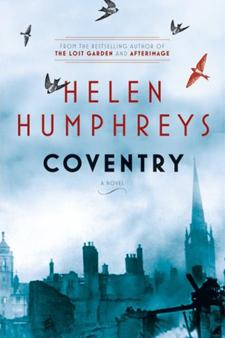With this fifth novel Humphreys returns to Great Britain during World War II, which was the setting for her third novel, The Lost Garden. The focus this time is on the city of Coventry on the night of Nov 14, 1940. On that night, the city, a significant manufacturing centre, was the target of a devastating German air attack. In the opening chapter we meet Harriet Marsh who is taking a shift as a fire-watcher as the bombing begins. Humphreys tells us, “For a few minutes the fire-watchers live up to their name — four dark figures stamped against a moonlit sky standing sentinel on the roof of the cathedral while the edges of the city begin to curl up and burn.” Through the night that metaphor becomes real.v
The second chapter of the novel slips back to the early months of World War I just when Harriet’s husband Owen enlists in the army. Humphreys lays the emotional foundation of the novel in this section when she describes the brief period of something like happiness that Harriet experiences when she meets and marries Owen. On the morning of his departure Harriet meets a woman named Maeve and the two women spend the afternoon together; they agree to meet again the next day. That meeting never takes place and for Harriet, it becomes one in a series of disappointments particularly as Owen is reported as “missing presumed killed” two months after he left England. For Maeve, as we come to realize later in the book, this will be one of many brief connections that she makes throughout much of her restless life including the one that produces her son. As a single mother long before it was acceptable, constant movement is both a strategy and an inclination of her temperament.
Moving forward to 1940, Harriet meets Jeremy, Maeve’s 22-year-old son, who is a fire-watcher on the cathedral roof with Harriet on the night of the bombing. The two characters walk through Coventry during the bombing with Harriet helping Jeremy find his way home — he has only recently arrived in the city. Of course she has no idea who his mother is. Their walk through the city is graphically described: the fires, noise of the bombers overhead, the random destruction of buildings, the landscape and the human inhabitants is vividly captured and the effect is disturbing. There are people trapped under buildings, fires burning throughout the city, streets blocked by collapsed buildings and dust and smoke everywhere.
The depiction of the physical damage of war is one key element in the novel. The other, of course, is about the psychic damage: The interrupted lives, the difficult decisions individuals must make under awful circumstances and the inescapable burden of memory for those who live through so much loss. Humphreys presents the aftermath with grace, subtlety and no trace of sentimentality. She has always done that in her fiction and she just keeps getting better and better. The economy of the prose, combined with the immersion in a period and place are part of why her work is so moving.
There is a lovely dream-like sequence toward the end of the novel that creates the opportunity for a little self-reflective artistry. In her exhaustion Harriet observes “the good thing about books is that they remain themselves. What happens in their pages stays there. Harriet does not like the idea of the story bleeding through into real life. She trusts a story, and doesn’t trust real life. But what makes her trust a story is the knowledge that it will stay where it is, that she can visit it but that there is no chance it will visit her.”
Harriet comes to understand that the distinction between so-called real life and story is more complex than she thought. By the time the novel concludes she understands that stories can be a way of making sense of real life and that telling stories is a necessary component of real life and an effective way to cope with loss.

 Why you can trust Xtra
Why you can trust Xtra


